Science in the Public Realm: How Design Helps Tell the Story
With so many important science and research institutions around the world, what's the best way to share their knowledge with the public? We have some ideas.
View Post
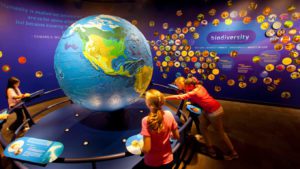
Even in times of economic uncertainty and shifting priorities, when broader agendas may draw focus away from urgent climate causes, we find abundant reason for optimism. Across communities, countless individuals and institutions continue to advance innovation, resilience, and a vision for a better world, often from the ground up.
We’re spotlighting our clients and colleagues who are leading by example, propelling forward initiatives in climate action, wildlife and habitat conservation, and ocean protection. Their determination reminds us that meaningful progress doesn’t wait for perfect conditions; it grows from people and organizations who believe in possibility and work tirelessly to shape a brighter, more sustainable future. We’re inspired by the range of initiatives, from the small lifts to the heavy push – they all move the needle.

CambridgeSeven is currently working with Woods Hole Oceanographic Institution and UC San Diego’s Scripps Institution of Oceanography on this year’s Ocean Pavilion for COP 30, UN’s annual conference on climate change. The Ocean Pavilion is an educational and discussion hub that is designed to convey the importance of the ocean at a human and planetary scale. This year’s pavilion will highlight themes such as ocean life and biodiversity, carbon and climate, and the blue economy and finance. COP conferences are attended by representatives from nearly 200 countries, including heads of state, government officials, climate scientists, activists, and business leaders as well as journalists and media influencers. For the last several years, CambridgeSeven has been involved with the design of these pavilions that have attracted thousands and helped share and bolster the message that the ocean is vital to all of us and we must work together to protect it.
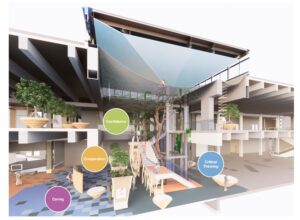
Our long-time partner, The Museum of Discovery and Science Ft. Lauderdale, FL, encourages children to explore STEM topics in highly-interactive ways, developing a love of learning and advocacy from a young age. Their upcoming exhibit, Build a Better World, is a novel climate resilience and character education exhibit that uniquely combines intra-personal development with exploration of the physical world around us. It’s designed to provide children with tools to understand the environmental stresses of their region, integrating science and climate concepts with positive character traits such as resilience, optimism, self-efficacy, and problem-solving skills. The overall exhibit is organized around the 4Cs of character: Caring, Cooperation, Confidence and Critical Thinking, with the aim of inspiring future leaders, innovators, and compassionate citizens who will, indeed, build a better world together.
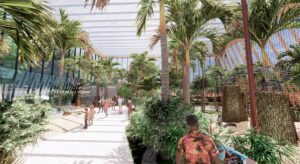
The new Entry and Tropics Pavilion at the Seneca Park Zoo improves the visitor experience and introduces new exhibits that connect the rich local river system with globally important valley ecosystems in distant tropical locales, highlighting the similarities of the conservation stories. Programmatically, this addition will help augment the Zoo’s conservation and education mission. Physically, it embodies its purpose as its design is composed of sustainable materials, native plantings, sensitive scale and siting,
The entry plaza will serve as the new entrance and provide spaces for immersive and informal learning, community gathering and animal interactions. The 65,000 SF, multi-story building features rainforest habitats and aquariums, providing a holistic view of the interconnected ecologies of diverse tropical environments. This new addition will contribute to the Seneca Park Zoo’s continued efforts in conservation science, animal welfare and innovative programming.
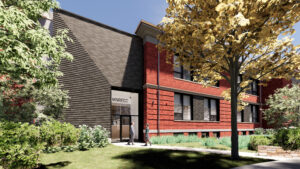
While exploring options to help the City of Revere, MA transform a former elementary school into a multi-use municipal hub with community spaces, offices and a new early childhood education center, we seized the opportunity to encourage the city to also improve the energy performance of this 1904 building. Despite having no energy standards or requirements in place, the city adopted our team’s recommendation to make the building all-electric. Another component of this building’s adaptive reuse is the design of a new emergency call center in the building’s 1927 addition and once again we arrived at an all-electric solution that simultaneously reduces non-renewable energy consumption and creates a healthier work environment for city staff. Upon completion, these projects will be among the first fossil-fuel-free municipal facilities for the City of Revere. By choosing to reuse existing buildings for new programs rather than demolition, Revere shows that local governments can act on their own to move toward change.
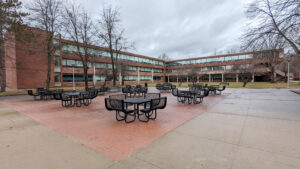
Small regional schools with modest budgets can also make impactful sustainable decisions and we’re helping with one such college, Northern Essex Community College (NECC), with targeted upgrades. The 60,000 SF 1970’s Science and General Services Center suffered from deferred maintenance and needed updates to the roof, windows, doors, and HVAC system to meet Massachusetts’ sustainability goals of NetZero. Our team is seizing this chance to modernize the building’s original electric heat system (with no air conditioning) to an air-source heat pump system. Now the building will meet sustainability goals and improve thermal comfort for occupants year-round. The renovations will increase the building’s energy efficiency four-fold simply through these hyper-focused areas of improvement. The biggest impact was achieved through clever detailing at the window framing, which allowed for better thermal insulation and minimal heat/cold transfer that is typically problematic in concrete buildings with aluminum framing.
In recent months, we’ve seen educational and research institutions that rely on federal funding and assistance hampered by disinvestment. However, we’re also seeing institutions redouble their efforts and maintain their course of innovation despite these headwinds.
Among the institutions who are investing in initiatives and projects that comprehensively push for progress on multiple fronts is Northeastern University, which is using their resources as one of the country’s most innovative schools to change society’s expectations of universities.
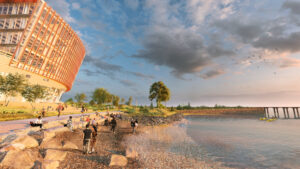
At the Roux Institute at Northeastern University in Portland ME, they are reinventing the way universities approach academics, an approach manifested in our design of its new Portland campus, with the intent of forging an improved path to climate-responsive regenerative design for the built environment in Maine.
An important project goal is to prioritize sustainability measures that will expand opportunities for the city, state, region and beyond to achieve higher levels of sustainability in other future projects. Goals include achieving a Net Zero Carbon Ready building through all-electric building operations and systems, the use of recycled content for steel and low-carbon concrete, the use of responsibly sourced mass timber, and a drastic reduction in construction waste being sent to landfills.
The project also strives to enhance the way building occupants and the greater Portland community work, live and learn, in part by creating a healthy environment through methods such as using PFAS-free and Red List-free interior finishes and using natural materials, biophilic design and daylight optimization to improve occupant well-being.
We applaud and celebrate these institutions and the individuals behind them who continue to strive for a world that is healthier, informed, more equitable, and more prosperous.
“We have the choice to use the gift of our life to make the world a better place – or not to bother”
―Jane Goodall
With so many important science and research institutions around the world, what's the best way to share their knowledge with the public? We have some ideas.
View PostHow CambridgeSeven's work with zoos, aquariums, museums and research institutions strengthens their conservation education efforts.
View PostFX Magazine - May/June 2025
Principals Adam Mitchell and Marc Rogers offer their expertise in designing projects that combat extreme weather due to climate change for FX Magazine's May/June Issue.
View Post